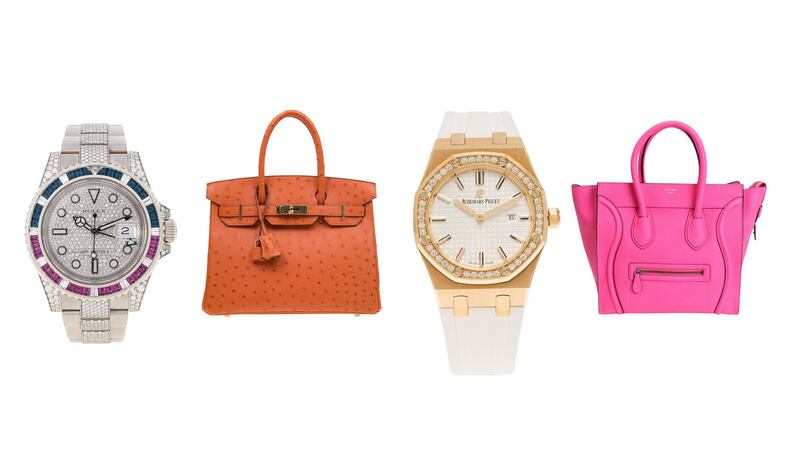I use my smartphone for three main things: communication through e-mail and WhatsApp, photo-sharing through Instagram, and online shopping. The latter is a newfound habit, one that I have only really developed over the past year or so. Previously, I would browse online shopping sites from a laptop or tablet at home. But recently, I have taken to scrolling through the new-in pages on apps created by luxury fashion sites. It was when I found myself haphazardly checking the My Theresa app one morning, when I should have been concentrating on something else entirely, that I realised two things: my addiction to online shopping had reached dangerous levels and there had to be more consumers like me out there.
Indeed there are – and that is why international e-commerce sites, including those based in the UAE, are repackaging their business strategies to take a mobile-first approach, and adapting their sites to suit the needs of mobile-shoppers, as opposed to desktop or laptop shoppers, is their new priority.
With retail continuing to advance digitally, consumer habits are changing all over the world, and the UAE is no exception. According to the Telecommunications Regulatory Authority, in the first quarter of this year, mobile-phone usage in the UAE increased to at least 228 phones per 100 people.
According to Andy Burton, chief executive of London-based e-commerce developer Tryzens, smartphones are the Swiss Army knives of today's digital generation. To accommodate this shift in the market, retailers are not only launching online e-commerce portals to sell their wares, they're also figuring out how to best do so from a smartphone standpoint.
"Mobile-first is the way forward now," says Kunal Kapoor, founder and chief executive of UAE-headquartered The Luxury Closet, a website that sells new and pre-owned designer apparel and accessories. According to Kapoor approximately 60 per cent of The Luxury Closet's revenue so far this year has been produced by mobile transactions, although exact figures vary from month to month.
If e-commerce platforms want to survive long-term, they will have to step up their mobile-savviness. Google recently announced that from next year, its search algorithm will take into consideration the mobile-friendliness of a website when determining its position in search rankings. So if a site isn't adapted for smartphones, and if its normal desktop site is the one viewed when accessing it through a mobile, its search status will drop, which will most likely cause a decline in traffic to the website.
While shopping for household groceries and electronics through mobile platforms such as Instashop and Souq may be picking up steam in the UAE, purchasing high-priced luxury goods online, let alone through smartphones, hasn't been a widespread practice. Customers have traditionally wanted to research and inspect high-value items first-hand before making a significant splurge, rather than sending notable sums of money through a speedy, spur-of-the-moment transaction on their phone.
However, this seems to be changing. When Net-a-Porter was chosen by Cartier to launch the Panthère watch earlier this year, it became the luxury brand's first third-party online retail partner, with the most expensive timepiece priced at Dh625,600. Some were sceptical about whether such costly luxury items would sell online, but Net-a-Porter has since revealed that it sold an 18-karat rhodiumised white gold, diamond and enamel Panthère de Cartier watch for Dh561,600 – not just online, but through a WhatsApp order.
According to Net-a-Porter, almost 50 per cent of its sales, including sales from its menswear site, Mr Porter, are made through mobile devices. It helps that its customer service representatives are active on WeChat, WhatsApp and email.
While it is essential for an e-tailer's website to be mobile-friendly, apps for both iOS and Android users are also vital. It is far more convenient for a shopper to click on an app icon than to open up a search engine or type in a URL.
"Your app allows a business to communicate with a client through one of their most trusted and important channels they have, and you reach them directly in their private space on their phone," explains Kapoor. When The Luxury Closet noticed that most of its website visitors were iOS users, it created its iOS app, which launched in September last year. Ten months later, it launched its Android app.
London-based luxury retailer Matches Fashion also launched an app a year ago, and recently announced that 50 per cent of its business is now generated via mobiles. Last month, it debuted a segment called Style Daily on its app, feeding users daily curated content to push its products. The editorial campaigns all feature items that are available for purchase, and the app sends notifications to subscribers as new content becomes available.
"Storytelling is such an important part of what we do and how we engage our customer, and Style Daily will provide a new digital touchpoint," says its global content director Kate Blythe. "This was a collaboration across the business, harnessing expertise from our mobile, tech and content teams – all aspects of the build have been created specifically with a mobile audience in mind."
While developing user-friendly apps with unique content is important, social media is equally, if not more, significant in driving sales, and some luxury businesses are giving special focus to Arab consumers. New York-based online-shopping platform Shopbop, for instance, partnered with Dubai-based social-media personality Saufeeya Goodson to promote its Ramadan edit this summer, through an Instagram campaign celebrating modest fashion. "We find that our Middle East customer really responds to the trend-driven product that we are focused on sharing around the globe," Shopbop chief executive Darcy Penick says. "We continue to invest in market specific content on localised social channels – namely Instagram – to engage our Middle East customer."
Shopbop recently underwent what it calls a "brand refinement", in which it updated its logo, colour palette and typography, introduced new layouts in terms of product-presentation, and added to its international payment options. Some of the app features are more advanced than some competitors'. For instance, users can swipe through different angles of a single product from the main page, rather than having to click onto the product and be directed to a new page.
But as luxury items become available to the masses through a series of clicks on a no-frills app on a mobile phone, does this go against the essence of what "luxury" is supposed to mean? By definition, aren't luxury items supposed to be exclusive, rare and hard to obtain? Can e-commerce platforms retain that sense of exclusivity, while appealing to an ever-broader audience?
Newly launched LVMH-owned website 24 Sèvres, which is based in France and prides itself on its selective, Parisian edit of luxury labels, does this through the presentation of its products. While its competitors shoot products against plain white backgrounds, designs from labels such as Louis Vuitton and Christian Dior are displayed on gold-wired mannequins or wooden and cement blocks, against grey or pink backdrops.
Even so, when 24 Sèvres launched, it did so with a dedicated iOS app, showing that it has recognised the need to not only present products beautifully, but also to offer that experience via mobile phones.
Given the amount of research about mobile-phone usage, and first-hand experience from retailers about sales through mobile transactions, it is understandable that even the most expensive e-tail platforms are taking mobile-first approaches. But does this mean that the future of digital-shopping could be mobile-only, without the use of computers at all?
Stephan Schambach, author of Makeover: How Mobile Flipped the Shopping Cart and founder of NewStore, a Boston-based mobile commerce developer that works with brands such as Adidas, certainly believes so. He has hypothesised that within just a few years, desktop-shopping will have died out and digital retail transactions will be mobile-only.
Yoox Net-a-Porter chief executive Federico Marchetti has expressed his plan to be at the forefront of this digital shift. "One of my biggest objectives is to transform the company into a mobile-only company," he told the Associated Press last year, theorising that by the end of 2020, three-quarters of the business's total sales will originate from smartphones and tablets.
In the UAE, then, considering there is an average of more than two phones per resident, it is likely that digital shopping practices will reflect international consumer behaviours. "Looking at current trends and already existing technology available, mobile-only is realistic," Kapoor says.
As an avid online shopper who already does the bulk of her browsing through a smartphone, these predictions for the future don't surprise me. But there is a potential downside to the widespread trend, if a mobile shopper fails to save his or her splurges for the appropriate time and place. There is a chance that we could all become desensitised to round-the-clock mobile usage, and that the chase for instant gratification, even in luxury e-tail, could lead to further phone addictions and antisocial behaviour.
______________
Read more:
[ Five headphones: which ones suit you best? ]
[ Brooklyn-bound fashion shoot - in pictures ]
[ A sneak peek into Johnny Depp's horse farm in Kentucky ]
______________






